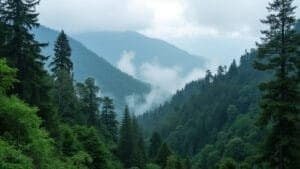Red pandas naturally live in the cool, temperate forests of the Eastern Himalayas and southwestern China, where high elevations, dense tree cover, and bamboo-rich undergrowth create an ideal habitat. These elusive mammals are found in countries like Nepal, Bhutan, India, Myanmar, and China—regions known for their steep, mountainous landscapes and lush, moisture-laden woodlands
Living primarily between 7,200 and 15,700 feet above sea level, red pandas are arboreal creatures that spend most of their time in trees, where they forage, sleep, and evade predators. Their preferred environments are forests with a mix of broadleaf and conifer trees, where moss-covered branches and a cool microclimate support the growth of bamboo, which makes up the majority of their diet
In this article, we’ll explore where red pandas live in the wild, including the specific countries, elevation zones, and forest types they inhabit. We’ll also examine the two red panda subspecies and why understanding their habitat is essential for conservation efforts amid growing threats like deforestation, fragmentation, and climate change
Natural Habitat of Red Pandas in the Wild

Red pandas thrive in a very specific environment shaped by the rugged terrain and cool climate of Asia’s mountain ranges. Their presence across several countries reflects both their ecological needs and the geographic conditions that support their survival. From steep slopes to dense bamboo forests, every aspect of their habitat contributes to their highly specialized lifestyle
Countries Within the Red Panda’s Native Range
Red pandas are distributed across five countries in Asia, all of which are located within or near the Eastern Himalayan region. These countries include Nepal, Bhutan, India, Myanmar, and China. Each nation provides key pockets of forested habitat where red pandas can find the food, shelter, and climate conditions they require
In Nepal, red pandas inhabit protected zones like Langtang National Park, Annapurna Conservation Area, and Makalu Barun. These regions offer high-altitude forests that meet their needs for bamboo and canopy cover. Bhutan also supports strong red panda populations, with forest corridors that stretch across its entire northern and central mountain ranges
In India, red pandas are found in the northeastern states, particularly Sikkim, Arunachal Pradesh, and parts of West Bengal, especially around Darjeeling. These states are rich in mixed coniferous and broadleaf forests that host dense bamboo growth. In Myanmar, red pandas inhabit the northern mountain regions, where their range overlaps with that of China
China—specifically the provinces of Sichuan and Yunnan—contains the largest share of red panda habitat. The temperate forests in these provinces, particularly in the Minshan and Qionglai mountain ranges, offer a favorable combination of bamboo-rich undergrowth, high humidity, and tree diversity. These areas also support protected reserves like Wolong and Gaoligongshan, which are important for long-term species conservation
As emphasized by the Red Panda Network, nearly half of the red panda’s remaining wild population lives in the Eastern Himalayas, making international conservation cooperation across these countries essential to their survival
Elevation Range and Mountain Ecosystems
Red pandas are most commonly found at elevations between 7,200 and 15,700 feet (2,200 to 4,800 meters). These high-altitude environments are cooler, wetter, and more forested than lower regions, providing the microclimate necessary for bamboo and other vegetation to thrive
Their optimal elevation range also minimizes competition from other mammals and reduces predation risk, as few large carnivores operate in the uppermost forest belts. Additionally, high-altitude forests have lower human population densities, which helps limit habitat disturbance
These mountain ecosystems are dominated by steep slopes, deep valleys, and extensive tree cover, including evergreen conifers and deciduous broadleaf trees. Red pandas have adapted to this vertical terrain, using their strong claws and agile limbs to climb and move easily between trees while feeding and resting
According to the World Wildlife Fund, these highland forests are often shrouded in mist or fog, creating cool, damp conditions that help bamboo flourish. These unique environmental features make these altitudes the ideal ecological zone for red pandas
Forest Types That Support Red Panda Populations
Red pandas prefer temperate broadleaf and mixed coniferous forests—biomes that offer both vertical structure and diverse vegetation. The most critical feature of these forests is the presence of dense bamboo understory, which is essential because bamboo makes up about 90% of their diet
These forests typically include tree species such as oaks, maples, firs, and rhododendrons. Many of the trees are draped in moss and lichen, which not only support insect life (a minor part of the red panda diet) but also help retain humidity in the forest. These moist microhabitats are vital during dry seasons and ensure that bamboo and other vegetation remain green and palatable
In terms of structure, these forests offer multiple canopy layers that provide safe passage and hiding spots. Red pandas spend most of their time off the ground, either resting in branches during the day or foraging at dawn and dusk. They select forest areas with mature trees for nesting and sleeping, while younger growth and bamboo thickets are used for feeding
The combination of food, cover, and climatic stability in these forests makes them the cornerstone of red panda ecology. Without intact forest systems that include all these elements, red pandas struggle to survive, which is why deforestation poses such a severe threat to their population
Geographic Distribution and Subspecies Differences

The natural distribution of red pandas spans a wide but fragmented landscape across Asia, and within that range, two distinct subspecies have been identified. These subspecies—Himalayan and Chinese red pandas—differ in physical traits and geographic distribution, yet they share similar ecological requirements. Understanding where these animals live and how they differ is essential for developing region-specific conservation strategies
Red Panda Range in China’s Mountain Provinces
In China, red pandas are primarily found in the mountainous provinces of Sichuan and Yunnan, as well as parts of Tibet. These areas are home to the Chinese red panda (Ailurus fulgens styani), which tends to be larger and darker in color than its Himalayan counterpart
The Minshan and Qionglai mountain ranges in Sichuan host some of China’s best-known red panda habitats, including the Wolong Nature Reserve, a UNESCO-recognized protected area. These regions offer mixed coniferous and deciduous forests at elevations between 7,000 and 13,000 feet, filled with arrow bamboo and old-growth trees suitable for nesting and feeding
In northwestern Yunnan, particularly in the Gaoligong Mountains, red pandas also find suitable habitat. These forests are rich in biodiversity and receive ample rainfall, supporting lush undergrowth and canopy structures. The Red Panda Network identifies these Chinese habitats as critical strongholds for red panda conservation, noting that these zones harbor isolated but viable populations
Characteristics of Himalayan vs. Chinese Red Pandas
The two red panda subspecies are genetically distinct and show subtle physical and ecological differences:
Himalayan red panda (Ailurus fulgens fulgens): Found in Nepal, Bhutan, northeastern India, and northern Myanmar. This subspecies is generally smaller and lighter in coloration, with a more reddish coat and pronounced facial markings. It typically inhabits slightly lower elevations within the red panda’s overall range
Chinese red panda (Ailurus fulgens styani): Found in Sichuan and Yunnan provinces of China. This subspecies is larger, with darker fur, a more robust skull, and less prominent facial markings. It has adapted to slightly colder and wetter environments than the Himalayan subspecies
These differences are significant enough that conservationists manage them separately, especially since their habitats do not overlap and face region-specific threats. Recognizing and maintaining genetic diversity between these subspecies is vital for ensuring the species’ long-term adaptability and survival. As noted by WWF UK, conservation strategies are increasingly tailored to the specific geographic and ecological needs of each subspecies. This targeted approach enhances effectiveness in habitat protection, reforestation, and anti-poaching programs
How Forest Structure Enhances Arboreal Living
Red pandas are arboreal by nature, spending most of their time in trees. The vertical structure of their forest habitat is a critical factor in their ability to live safely and successfully. In the wild, red pandas use tree canopies for:
Travel: They move from tree to tree in search of bamboo and fruit without descending to the ground, which reduces exposure to predators
Resting: Red pandas often sleep stretched out on broad branches or curled in tree hollows, protected by height and dense foliage
Shelter: Tree canopies provide insulation from the elements—shade in the summer and cover from rain and snow in the colder months
The forests in their range often feature multiple canopy layers, including an understory of bamboo, a middle tier of shrubs and saplings, and a high canopy of large trees. This stratification allows red pandas to exploit different vertical zones for foraging, shelter, and safety
Their claws, flexible ankles, and strong limb coordination allow them to climb with agility and descend trees headfirst—a rare ability among mammals. These traits make red pandas perfectly suited for life in the treetops, and any disruption to the forest structure directly impacts their survival
Conservation Relevance of Red Panda Habitat

The survival of red pandas is intimately tied to the health and continuity of their forest ecosystems. As an endangered species, red pandas face mounting threats from habitat degradation, human activity, and climate change. Understanding the geographic and ecological conditions of their habitat provides critical insight into how conservation efforts must be structured. These efforts need to protect not just the animals themselves but the complex, high-altitude environments that sustain them
Threats from Habitat Loss and Fragmentation
Across their range, red pandas are increasingly threatened by the destruction and fragmentation of their forest habitat. The expansion of agricultural land, livestock grazing, logging, and the development of roads and settlements have carved up once-continuous stretches of red panda territory into smaller, isolated patches. In areas such as Nepal and northeastern India, red pandas now often inhabit narrow strips of forest where movement between populations is severely restricted
This fragmentation reduces gene flow and increases the vulnerability of red pandas to local extinction. Solitary by nature and requiring relatively large territories, these animals are less likely to find mates or maintain viable populations when restricted to isolated forest pockets. Additionally, when red pandas are forced to cross exposed or developed areas to reach feeding or nesting grounds, they face higher risks from predators, human disturbance, and poaching
Efforts by organizations such as the Red Panda Network have focused on reconnecting these fragmented forests through habitat restoration and the establishment of wildlife corridors. These corridors enable red pandas to move safely between habitats, promoting genetic diversity and reducing the impact of isolation. Protecting larger, contiguous forest tracts is essential to reversing the trend of habitat fragmentation and ensuring population stability
Role of Climate in Forest and Bamboo Viability
Climate change poses a more insidious, long-term threat to red pandas by altering the very conditions that support their bamboo-rich forest environments. Bamboo, which forms the backbone of the red panda’s diet, is highly sensitive to changes in temperature, precipitation, and soil moisture. As climate conditions shift, bamboo die-offs or reductions in nutritional value are becoming more common, particularly in regions facing prolonged drought or erratic rainfall
The warming climate is also pushing suitable red panda habitat to higher elevations. While this upward migration may temporarily offset temperature stress, it compresses the available habitat into a narrower vertical range. In many regions, the peaks of mountains are either unsuitable for forest growth or already overpopulated with other plant and animal species, effectively creating a ceiling beyond which red pandas cannot migrate
Additionally, climate-driven changes in snowfall and snowmelt cycles are impacting the availability of freshwater in high-altitude forests. These shifts can dry out forest soils, affecting both bamboo growth and the tree species that red pandas rely on for nesting and cover. The combination of reduced food quality and deteriorating forest structure makes climate change a multifaceted threat that compromises every aspect of red panda habitat
Strategies for Preserving Red Panda Ecosystems
Effective conservation of red panda habitats requires a multifaceted and long-term approach. Protecting high-elevation forests is a foundational step, as these ecosystems provide the food, water, shelter, and climate stability red pandas need. Restoration of degraded lands within red panda range is also critical, particularly in regions where human activity has fragmented natural corridors
Conservationists are increasingly working with local communities to promote sustainable forest management practices that align with the needs of both wildlife and people. Community-based conservation models have shown success in areas like eastern Nepal, where local knowledge and involvement have led to measurable improvements in habitat quality and population monitoring
Adaptation to climate change must also be integrated into conservation planning. This includes identifying forest areas that are likely to remain stable under future climate scenarios and prioritizing them for long-term protection. Such proactive planning can help ensure that red pandas continue to have access to viable habitat even as environmental conditions evolve
International cooperation remains vital since red panda populations extend across national borders. Cross-border conservation agreements and unified wildlife management policies can enhance habitat connectivity and resource allocation. By preserving the forests that red pandas call home, conservationists are also safeguarding a wealth of biodiversity and critical ecosystem services that benefit entire mountain communities












